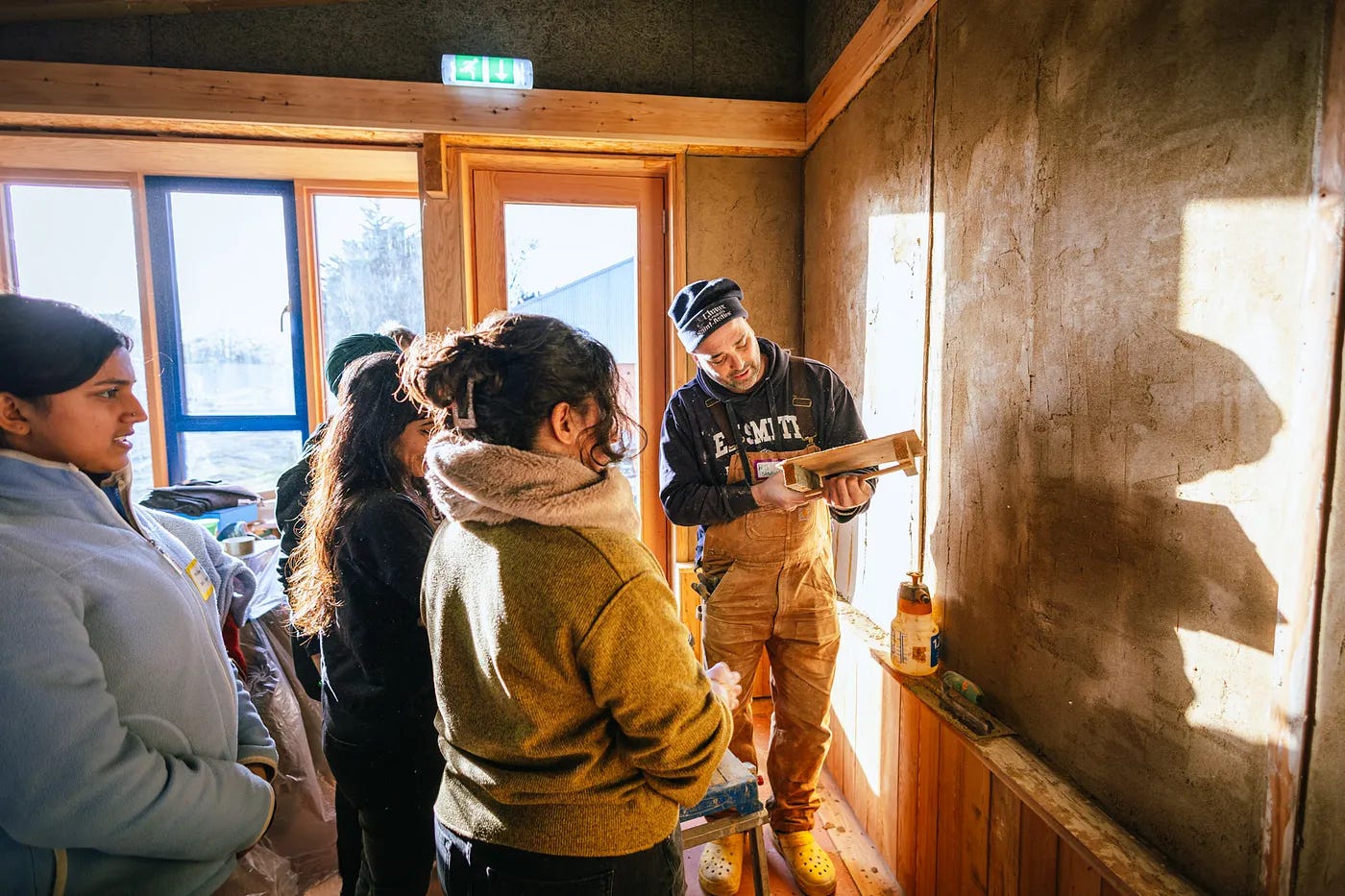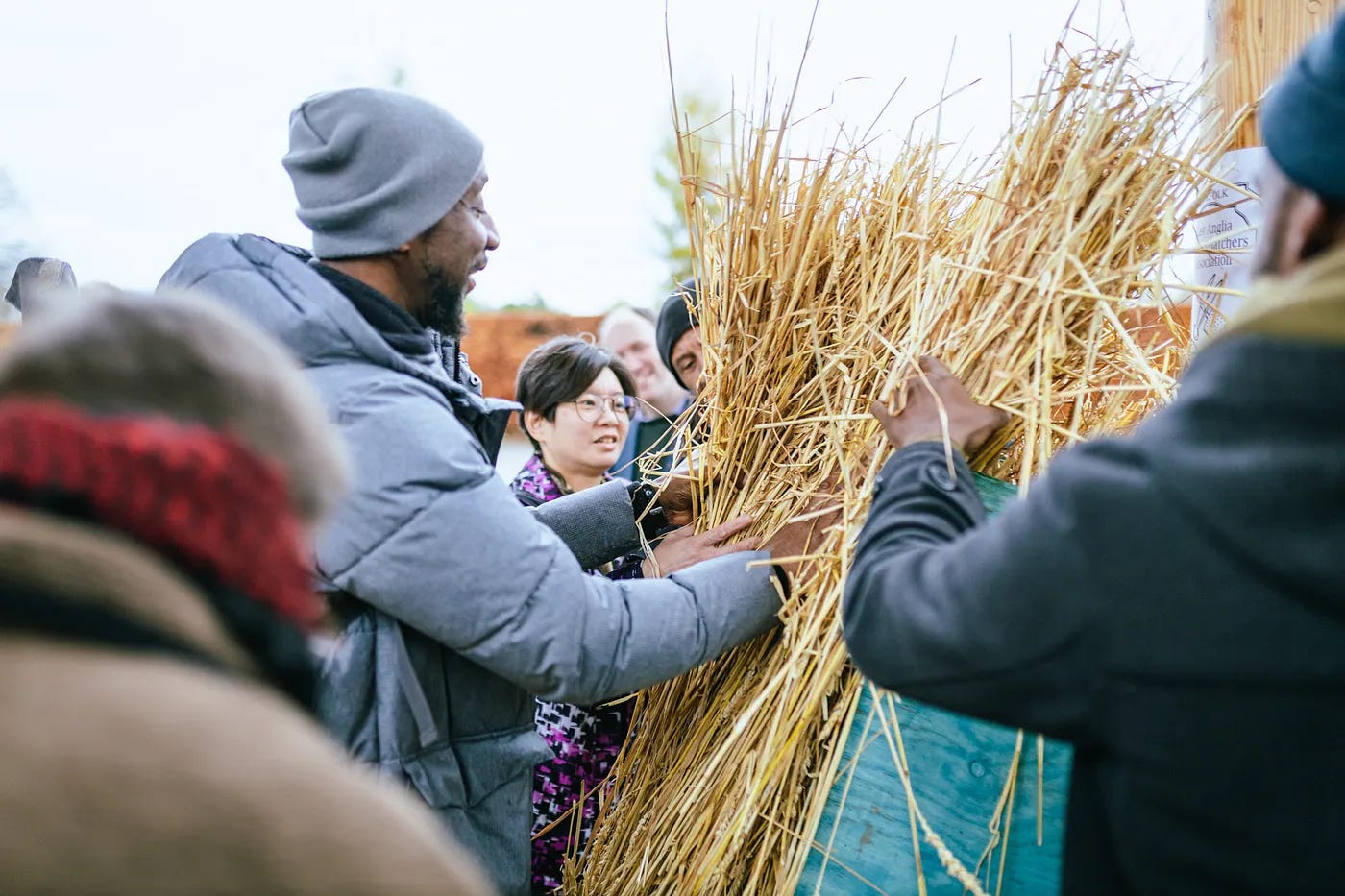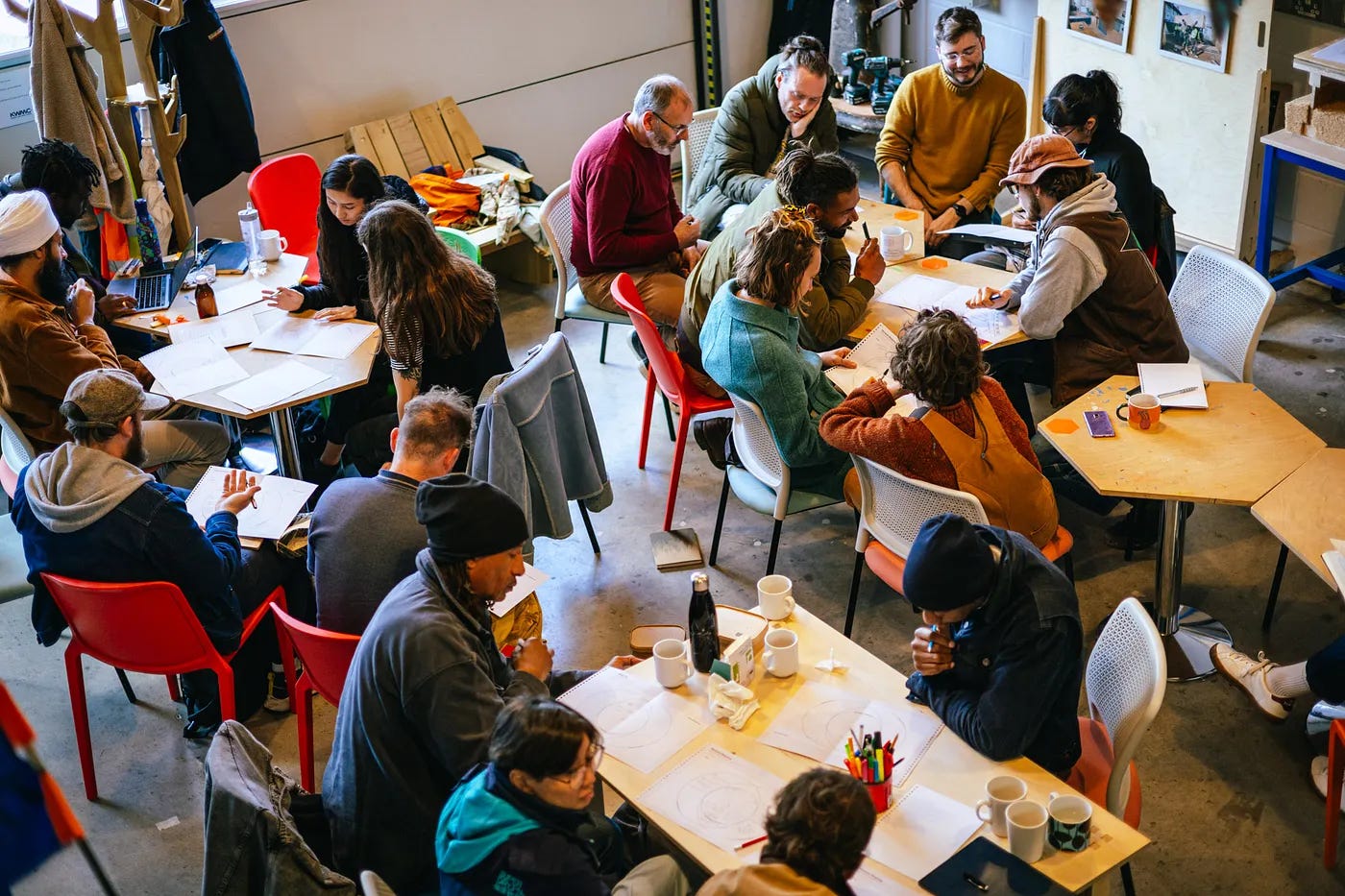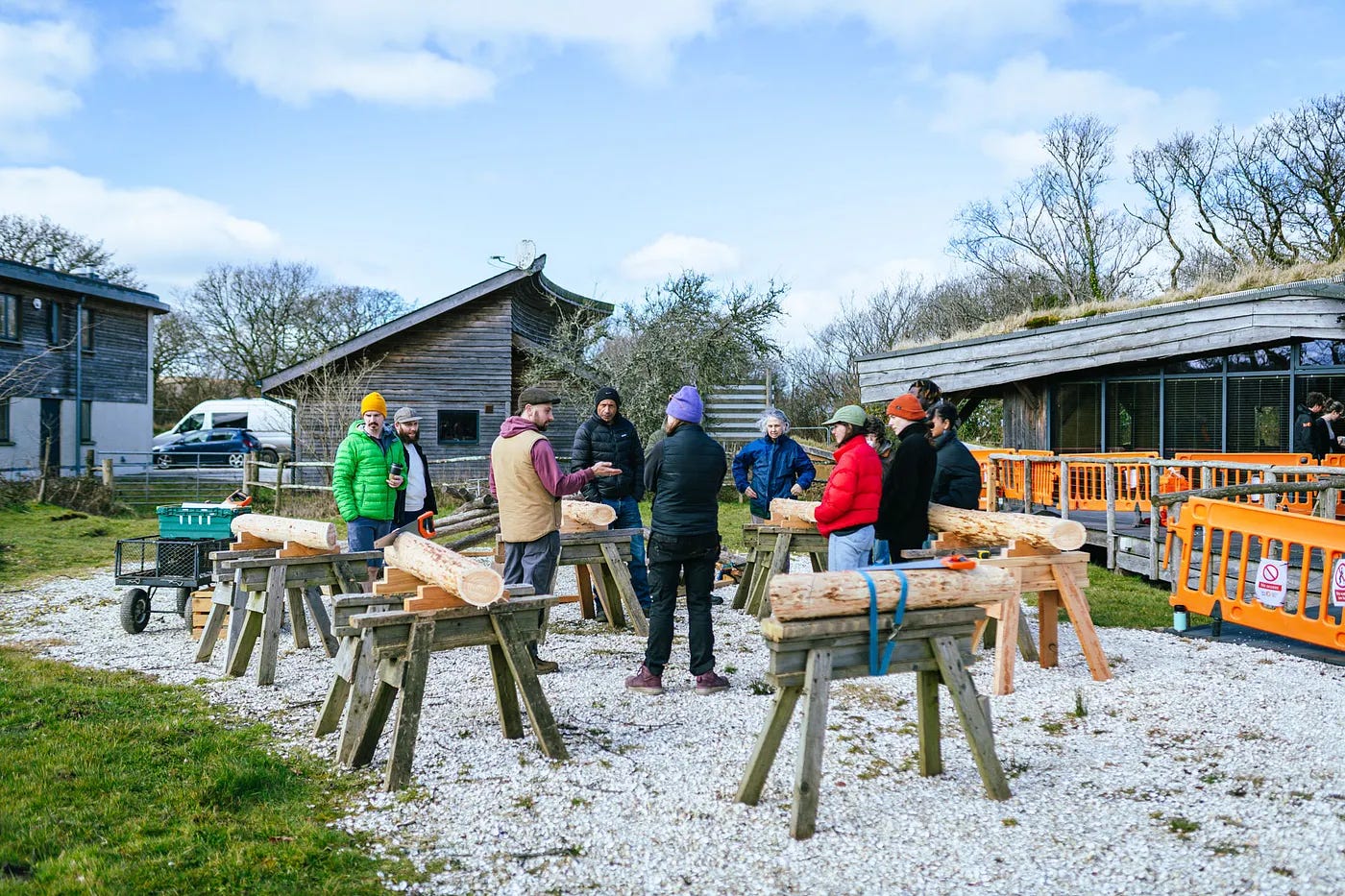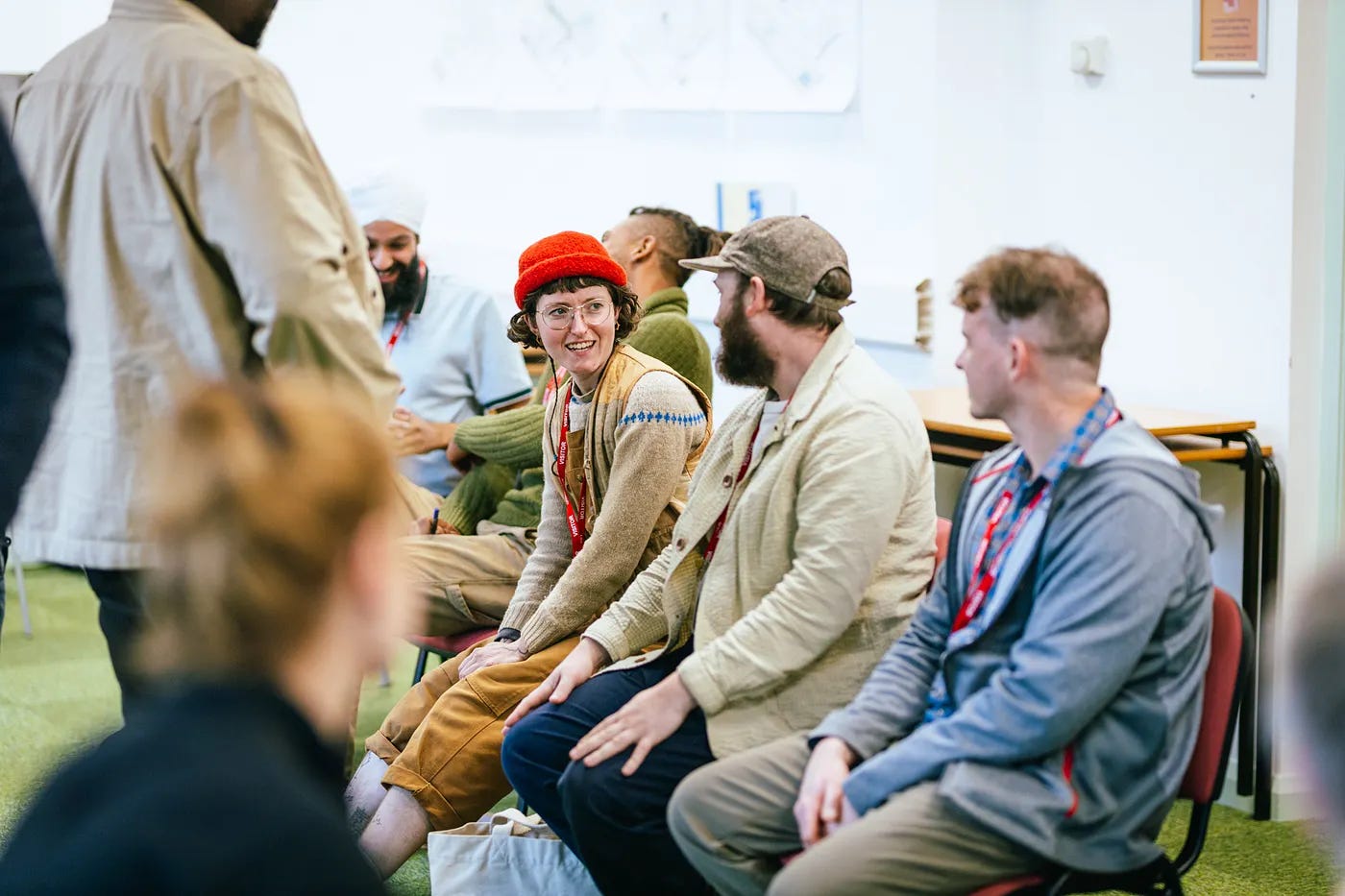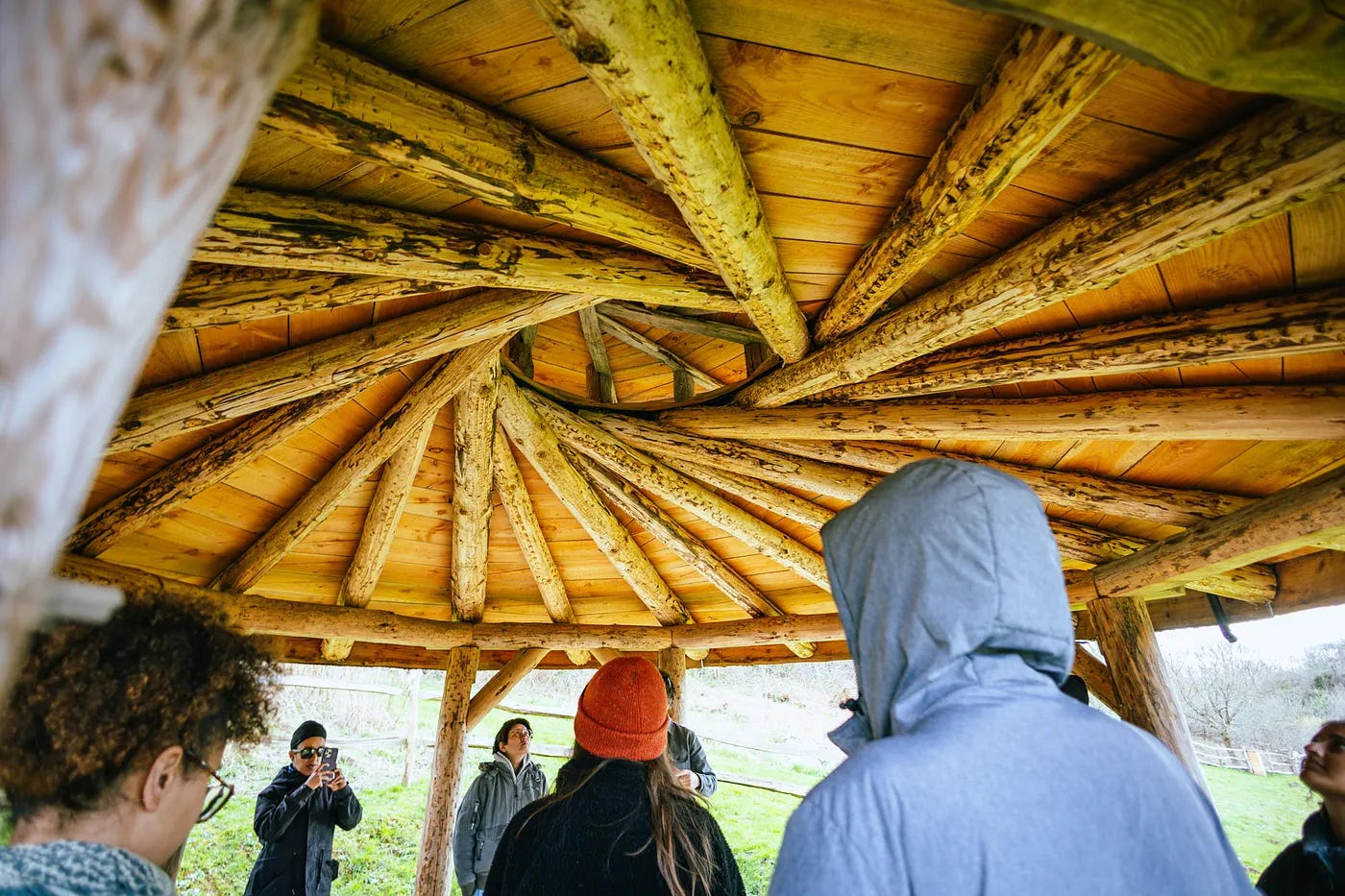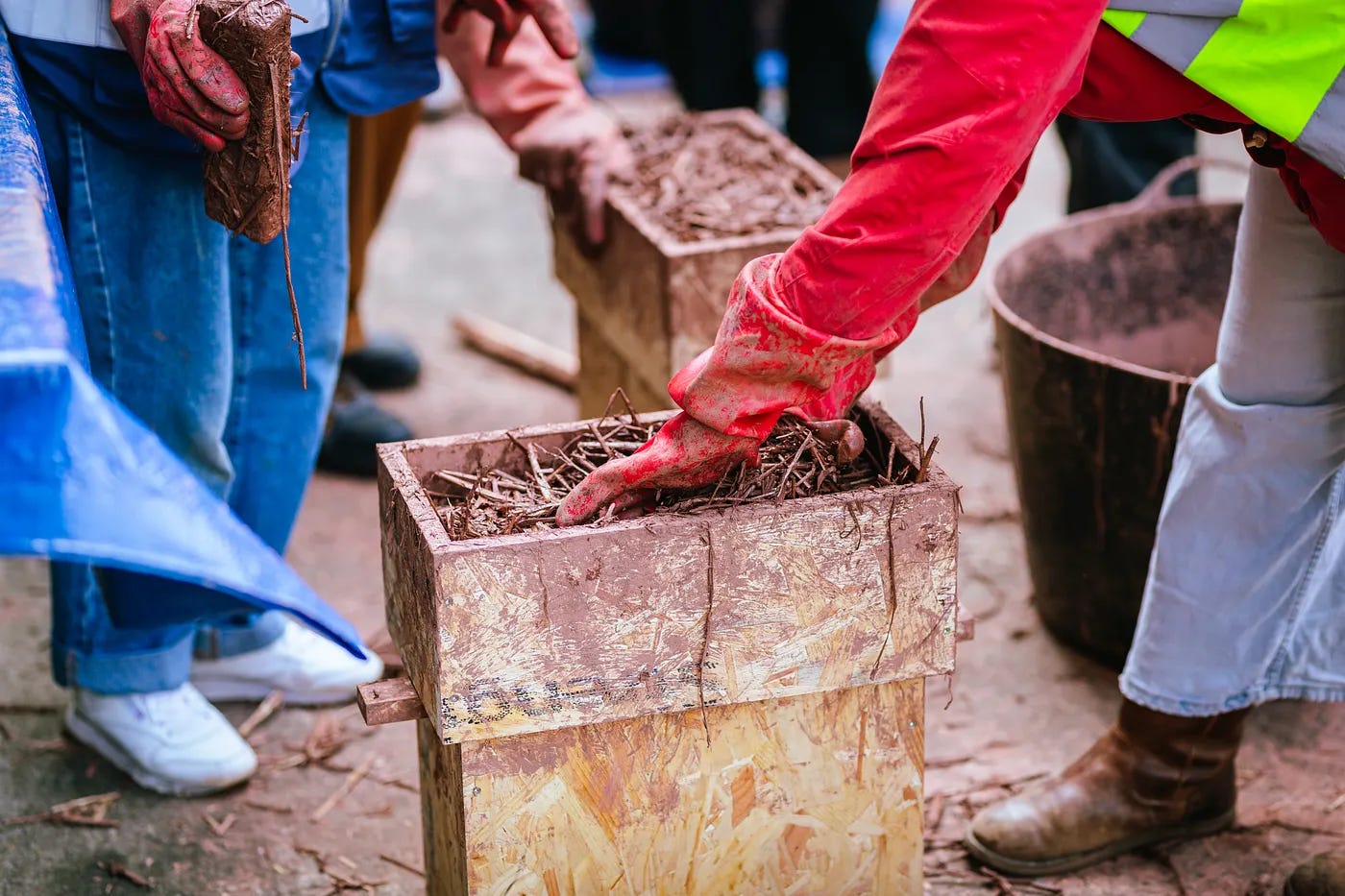Routes to Regenerative Construction
Reflecting on ReBuilders and what we learnt
The ReBuilders programme was a collaboration between Dark Matter Labs, CIVIC SQUARE, Material Cultures, and Fircroft College, supported by Innovate UK. This is our first reflection on the programme’s initial iteration; more documentation and resources will be shared by our partner organisations in the coming weeks.
In this piece, we will outline 5 ways we learnt over the course of the programme:
The retrofit design hack
2. In-person visits
3. The maintenance perspective
4. Sites as classrooms
5. Leadership with longevity
Between September 2024 and October 2025, we came together with a group of ten construction business leaders in the West Midlands to consider pathways toward regenerative ways of building. Over those six months, we visited leading-edge socially- and ecologically-regenerative buildings across England and Wales, met with the trailblazers involved in realising these projects, engaged in hands-on sessions working with natural building materials and assemblies, and thought deeply about organisational design as a cohort. In so doing, the group took steps toward modelling the transition we envisioned — both as individual practitioners and as a collective.
Programme highlights:
Four site visits, to WeCanMake (Bristol), UEA Enterprise Centre (Norwich), Wolves Lane Centre (London), Down To Earth Project (Gower Peninsula)
Hands-on demonstrations: Ecococon, lime rendering, Blokbuild, hempcrete, thatching, clay plastering, earth and light earth, closed-panel timber framing
One-to-one sessions and group talks with mentors and partner organisations in support of individual participants’ action plans, hosted by Fircroft College
ReBuilders was established with Bill Reed’s vision of regenerative practice in mind: that which goes beyond what’s deemed green, sustainable or restorative, to do not only less bad but to do more good, using whole systems thinking. Together with our partner organisations, CIVIC SQUARE and Material Cultures, we sought to curate a programme that negotiated the tensions of our aspirations:
Working with locally-embedded practitioners in the West Midlands while acknowledging the wider scale of entanglements in our supply chains, and the planetary-scale impacts of the construction sector
Acknowledging and enabling the idiosyncratic specificities of small-business operations, many of which are driven by personal priorities, while at the same time encouraging networks and identifying commonalities
Growing clarity and agency around the small actions and positions that this group of business leaders could take in the near-term, while keeping an eye on the bigger systemic shifts that are necessary for a just transition in the built environment
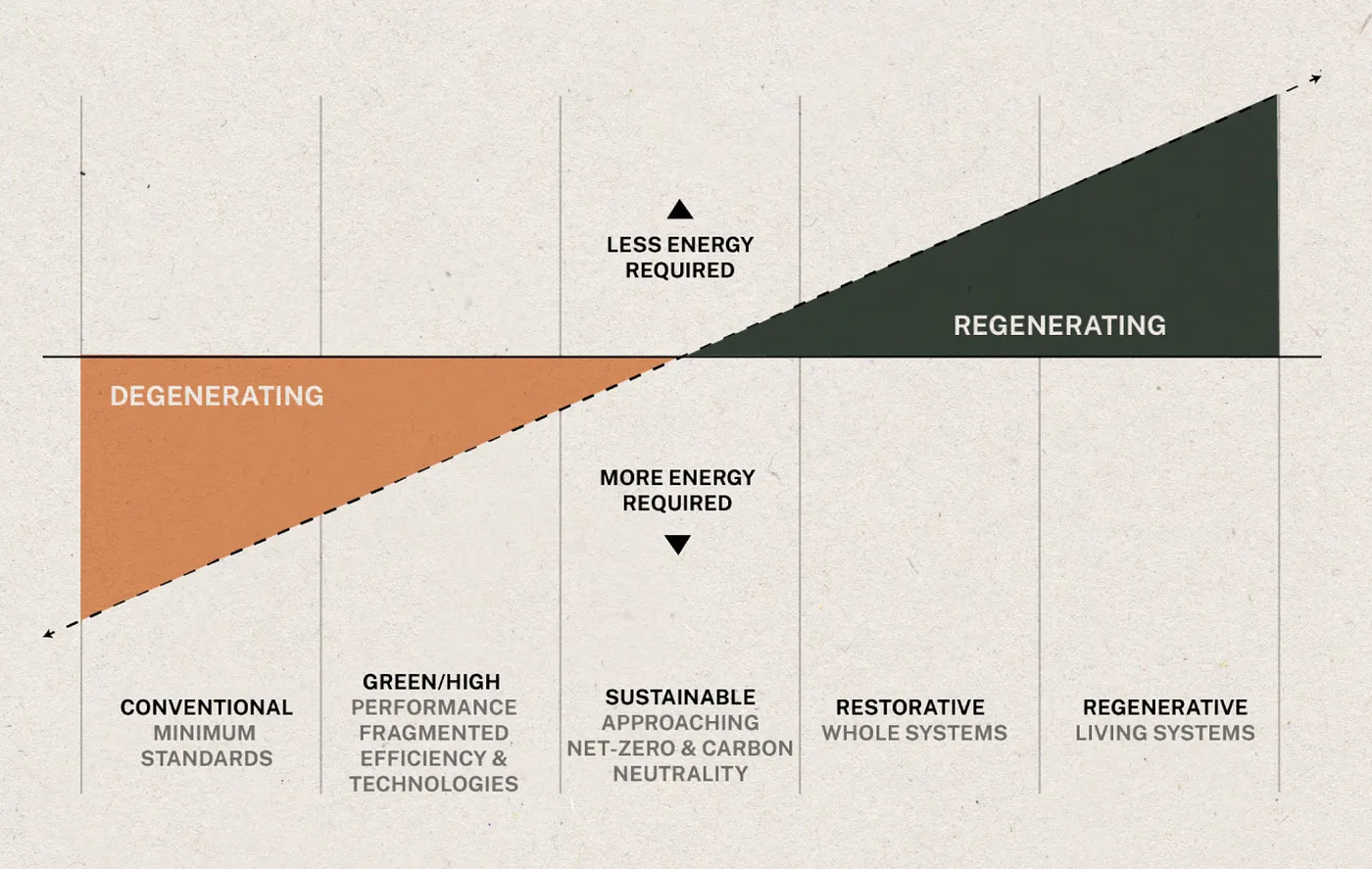
Ultimately, we aimed to show how outstanding regenerative buildings can catalyse changes in their eco-regions and beyond, and how individual businesses working regeneratively can similarly scale their impact to play an integral role in transitions from the neighbourhood-scale upwards.
While the programme offered opportunities for direct knowledge transfer across generations, perspectives, and areas of expertise, the transformative qualities of ReBuilders can be seen for their full expansiveness only in retrospect. Over the course of our time with the ReBuilders, in the range of planned and unplanned ways in which we came together, evidence of new ways of learning and working together emerged. These modes and methods sit within the ecosystem of reimagined civic infrastructures that define the area of our ongoing collaboration with CIVIC SQUARE, as laid out in our recent collaborative initiative around 3º Neighbourhoods.
3ºC Neighbourhood
3ºC Neighbourhood is co-authored by CIVIC SQUARE and Dark Matter Labs as a new piece of research that seeks to…
In this piece, we will lay out five ways we learnt and explored regenerative building practices in the collective setting of ReBuilders. These ways of learning posed important questions and pointed to possibilities around how we might move toward a self-sustaining ecosystem of regenerative practices and practitioners. In asking not just what but how we learnt, we hope to sketch possible methods for future coalition-building around a regenerative future for the built environment.
1. The retrofit design hack
How can we approach novel problems differently?
WeCanMake hosted a quick-fire ‘retrofit detail hack’; a thirty minute session that brought together small groups of ReBuilders to think through a particular design issue they’ve come across in their work. Armed with printout detail sections and pencils, the ReBuilders came up with possible solutions to the problem that drew on their different areas of expertise. Having previously presented this same detail to researchers and engineers from the University of Bath, WeCanMake noted that the builders came up with different solutions.
The nature of the exercise — quick, non-rivalrous and yet still competitive — pointed to new ways to think about solving retrofit problems of seemingly overwhelming scale. By reframing how we collate different types of knowledge and expertise together, the exercise reimagined how we could solve repetitive problems at the scale of a street or a neighbourhood.
The ideas formulated in these small groups were greater than the sum of individual approaches to the detail. The hack format created space for productive disagreement and collaborative feedback, building coherence across viewpoints and supporting a collaborative spirit in the room.
2. In-person visits
What can we gain from seeing evidence of the possible?
A key part of the programme was a series of site visits to existing examples of regenerative buildings and projects across England and Wales. Across the sites we visited we met with architects, builders, groundskeepers, community leaders and volunteers, as well as the people who call those buildings their workplaces.
Seeing the built examples and hearing from different perspectives was beneficial in and of itself, but there was a much more important aspect to these site visits that’s often overlooked in climate and economic transition thinking. The visits made it possible to imagine alternative future lives and livelihoods. Seeing these buildings in real life and meeting the practitioners not only presented evidence of alternative ways of building, but also led us toward a more visceral appreciation of what the ‘work’ looks like that brings these types of construction methods and practices to life.
Alongside this, we experienced for ourselves the palpable differences in the qualities of spaces created by bio-based buildings such as more comfortable temperatures and improved internal air quality, while hearing how people who lived and worked in these environments felt longer-term impacts on their mental wellbeing and functioning.
These site visits and discussions opened up different avenues of thought for the group, making the shift we’re working towards more tangible and more enticing.
3. The maintenance perspective
Who and what is in our regenerative building coalition?
As part of our session with ReBuilders mentor Irena Bauman, we met with Lisa, a member of Fircroft College’s cleaning team. In telling us what her team has to consider in planning the college’s maintenance, and giving us a tour of the spaces she works in and things she pays attention to, Lisa widened our view of the processes involved in making a building that’s fit for purpose over time.
Meeting Lisa raised the question of how we can better design and build in ways that can be regenerative past the point when architects and construction teams leave the site. What constitutes stewardship, when the building is in the hands of those who live in and maintain these structures?How can designers and builders align their work with the maintenance and care work that comes after they hand over the building?
Our ‘maintenance tour’ showed Fircroft’s building in relation to time. As an historic structure, we saw ways in which the building’s contemporary use doesn’t align with its original design, so Lisa’s team has to fit their large stores of equipment into tiny closets, but we also saw how materials like stone stand the test of time. Equally, Lisa’s work highlighted how important cleaners and other behind-the-scenes workers are to making places habitable through work that happens on cycles from daily to annual.
The time we spent speaking with cleaners and groundskeepers at Fircroft showed how we need to bring more voices in the room around regenerative building practices. Could we make more progress toward our goal of regenerative building if we better understood how construction workers and those who will later work in these spaces have many of the same priorities? Our cohort was excited by the idea of this continuum of stewardship and knowledge.
4. Sites as classrooms
What pathways does construction open up?
Community building processes at Wolves Lane and Down to Earth have been actively designed with a long-term vision of distributive, place-based regeneration in mind. Teams in both of these places drew us into their ambition to bring communities into the building process, and showed us how this can amplify the benefits of regenerative construction.
Community-led construction reframes stewardship of the building and moves beyond the logic of direct monetisation of places. We witnessed how regenerative architecture is defined by the pathways that are opened up over the course of decades, rather than being defined solely by what a building is worth or what it costs to build.
At Down to Earth, construction is positioned as a form of therapy that benefits health, while at the same time providing affordable, low-carbon homes to local residents in the Gower Peninsula — and they’ve done the quantitative research to back up these outcomes and share them with a wider audience. At Wolves Lane, the Ubele Initiative has co-designed the construction process with Material Cultures so that nearly everyone who’s likely to use the building has had a hand in its making, supporting the organisation’s aims of empowerment and social change. When we visited Wolves Lane (and got involved in clay plastering), we saw how this approach to construction maximises different benefits that can come from its component processes, treating construction as a durational resource for regeneration rather than just a thing to get done as cheaply and quickly as possible.
The pathways opened by regenerative building practices show us how it’s not just about the finished building, but about what doors can be opened on the way.
5. Seeing leadership with longevity
What comes after the stubborn trailblazers?
Barbara Jones of the School of Natural Building and Ecococon, and Mark McKenna of Down to Earth, represent examples of amazing leadership in this field by committed experts who, by their own account, have been told that their ideas were impossible or couldn’t be done countless times. In McKenna’s own words, “the established construction industry is determined, well funded and resolute in how it currently operates”, a challenge that calls for a large dose of stubbornness and belief that change is possible. The tenacity of leaders like McKenna and Jones has made headway for the next generation of practitioners, but it’s taken commitment over decades of learning difficult lessons to get to this point.
This points to the necessity of working in coalition, building relationships across disciplines and career stages, and fostering mentorship for building tacit knowledge of these practices.
Networks and forums (like ACAN) need to be enabled and seen as a key part of the ecosystem that will enable dissemination of knowledge and opportunity while building momentum and supporting longevity.
What’s next?
ReBuilders offered us a glimpse of what a 21st century, regenerative construction sector looks like. For this sector to be a part of neighbourhood-led, climate and eco-social transitions, there is a need for reimagined roles for construction workers and allied built environment practitioners. We are invested in reimagining and redesigning what future skills training and learning programmes look like, to create genuine routes into these lives and livelihoods. With our partner organisations, Dark Matter Labs is committed to exploring how to realise the emergent networks and initiatives that ReBuilders programme planted as seeds. Please reach out if you have aligned endeavours that we could work toward together.
For us at Dark Matter Labs, the programme strongly underscored the importance of working in alliance, identifying shared intent, and maintaining momentum toward change. With this in mind, we’ll soon share the collective resource database, initiated during ReBuilders, which we are transforming into a live index for the public.
Finally, we’re pleased to announce that the ReBuilders programme will be returning later in 2025. This second iteration of ReBuilders will focus on retrofit and embed the principles of Retrofit Reimagined, while further integrating the programme within CIVIC SQUARE’s work at neighbourhood level.
If you’re a leader of a small or medium-sized construction business in the West Midlands and interested in taking part, please keep an eye out for further news in the weeks to come by following CIVIC SQUARE, Material Cultures, and Dark Matter Labs on social channels.



